Vikings’ Scandinavian Saga: Unveiling the Mystique of Norse Mythology and Terrain
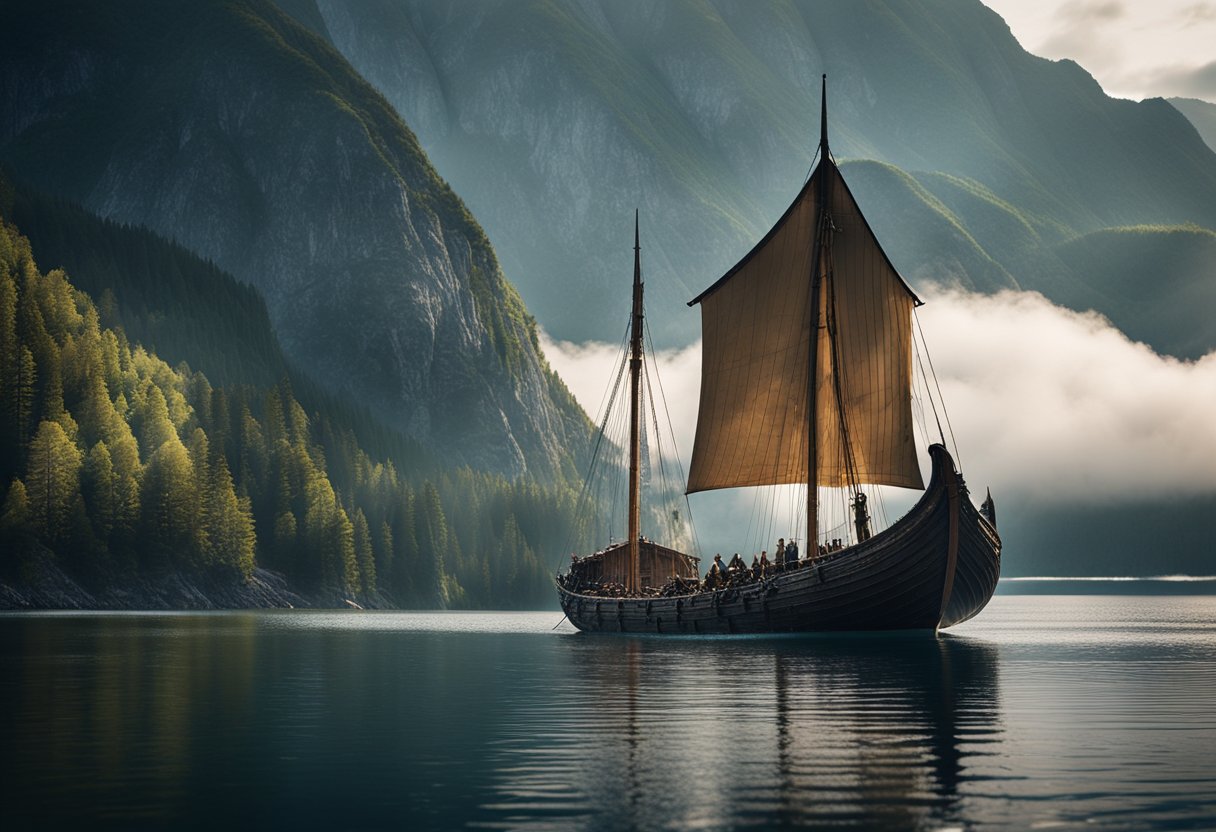
Updated On: April 15, 2024 by Eman Sameh
Exploring the rich tapestry of the Viking era unveils a saga woven with the threads of Norse mythology, robust societal structures, and ingenious seafaring technology. The Vikings, originating from Scandinavia, embarked on a series of expeditions that would mark them as traders, settlers, and formidable raiders during the Viking Age. Their sagas charted the narratives of their conquests, the landscapes they traversed, and the societies they impacted, leaving an indelible legacy on foreign lands.
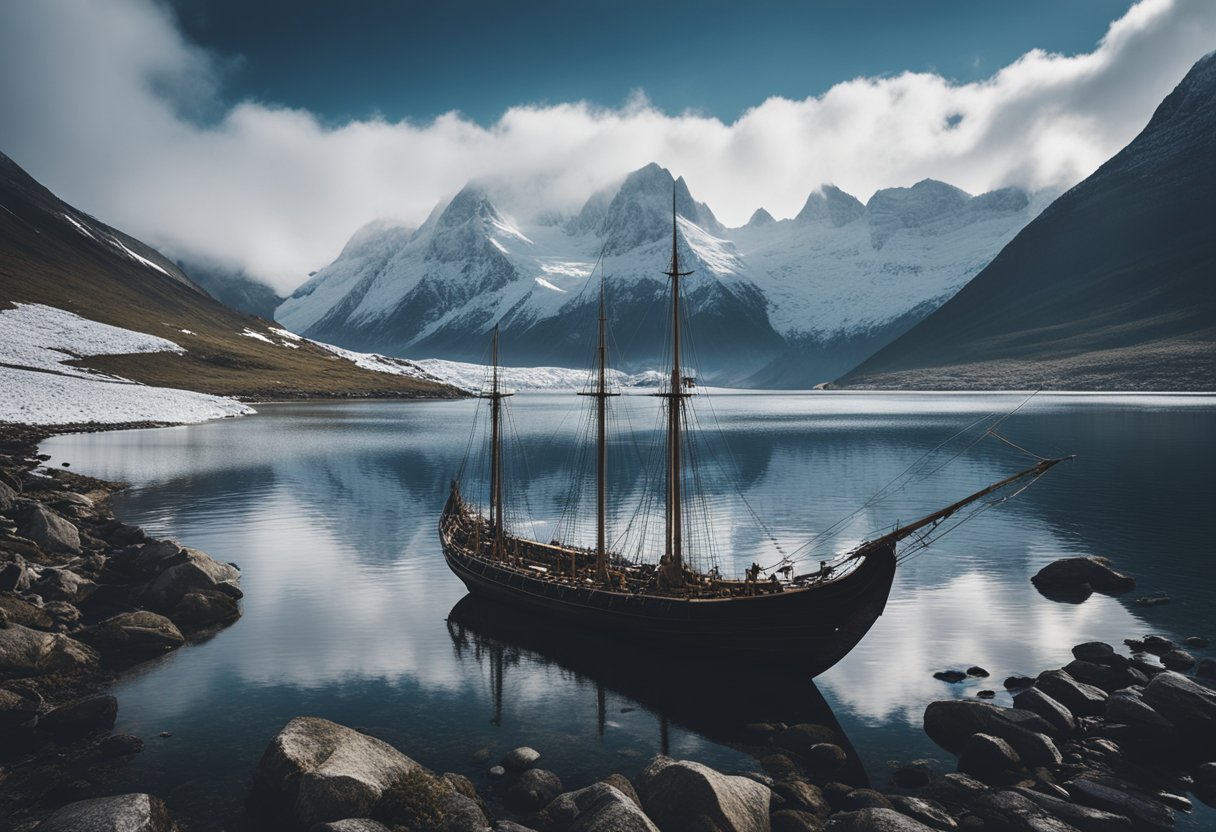
Their lore is encapsulated within the Norse sagas and Eddas, offering insights into their spiritual beliefs and practices heavily influenced by their deities, such as Odin and Thor. These stories go beyond just myth; they permeate every aspect of Viking life, from arts and artistry to societal structures and law. Scandinavia, the cradle of Viking culture, continues to be dissected by archaeologists intent on uncovering the truth behind the sagas—a truth that resonates with the echoes of the Norsemen’s past adventures and their enduring impact on the modern world.
Origins of the Norse Mythology
Intriguing and multifaceted, the Norsemen’s origins lie in the intertwining threads of culture and language that flourished in Scandinavia. They set the stage for what would become a pivotal era known as the Viking Age.
Culture and Society
We find that during the outset of the Viking Age, Norse society was structured with a clear hierarchy, where chieftains and nobles held power. Their culture was deeply intertwined with their surroundings, from the harsh landscapes of Scandinavia to the fertile regions in Europe. They were not just warriors; many were skilled seafarers, traders, and farmers. The Norse were part of the wider Germanic cultural umbrella, sharing many traditions and practices with their kin across Europe.
Their societal norms were underpinned by a rich spiritual ethos rooted in Norse mythology. These legends and beliefs were not just for entertainment; they were integral to Norse identity and societal cohesion. Celebrations and rituals were important as well, and communal ties within local and larger geopolitical structures were cemented.
Language and Sagas
The Norsemen spoke Old Norse, a North Germanic language, which has provided us with a wealth of knowledge through sagas. These sagas are not just simple tales; they are complex narratives that intertwine fact and fiction, history and legend. Among these, the Íslendingasögur, or the Sagas of Icelanders, offer vivid portraits of life during the Viking Age.
The Konungasögur, or the Kings’ Sagas, such as the Heimskringla, detail the lives and deeds of Scandinavian rulers. Another category, the Fornaldarsögur, or Sagas of Ancient Times, delve into legendary Nordic history, often with mythological and heroic themes. These sagas are fundamental texts that give us remarkable insights into the values, conflicts, and social structures of the time. They serve as a linguistic bridge to the past, allowing us to understand our shared heritage across Scandinavia and Europe.
Path of Conquest: Viking Raids and Expeditions
Through skilful navigation and fierce determination, Viking raiders left an indelible mark on history. They are known for their expeditions that spanned various regions, including England, Ireland, and wider Europe.
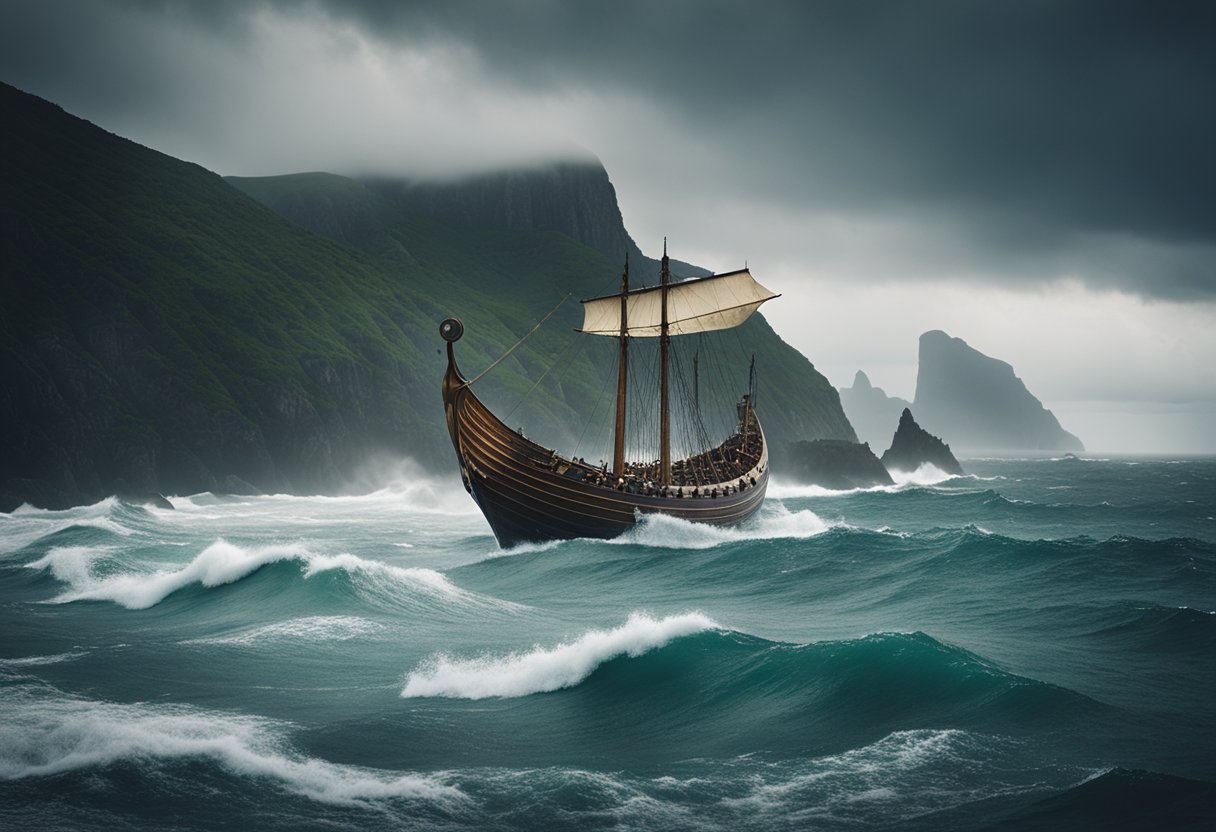
Raiding Strategies
Vikings employed advanced raiding strategies that relied on surprise attacks and swift ships. Their longships, with shallow drafts, allowed them to travel up rivers and catch settlements off-guard. In terms of combat, they favoured speed and surprise, often striking at dawn and retreating quickly before local forces could mount a defence.
Key Viking Raids
The raiding period began with the attack on the Lindisfarne monastery in England in 793, which sent shockwaves through Christian Europe. This was followed by numerous raids, such as the siege of Paris in 845 and the establishment of the Danelaw in England. Significant emphasis was also placed on the establishment of Normandy in 911, which was a direct result of the Norsemen’s influence. Across the North Atlantic, they reached as far as Vinland in North America, while their presence in Ireland led to the creation of Dublin. Iceland was settled by Norsemen seeking new territories, and their tales of exploration and conquest are deeply woven into the fabric of Norse legend.
The Viking Settlements Abroad

As we explore the expanse of Viking influence, it becomes clear that their legacy is not confined to Scandinavia. Their settlements abroad tell a story of adventure, colonisation, and cultural exchange.
Greenland and the North Atlantic
Greenland is a testament to their maritime prowess and colonisation efforts when considering the scope of Viking exploration. Norse settlers, led by Erik the Red in the late 10th century, established their first foothold in Greenland following his exile from Iceland. These settlements forged a vital link in the North Atlantic that paved the way for further exploration. Evidence of their presence is embedded in the archaeological remains of their farmsteads, which show a society capable of adapting to challenging climates.
Iceland and the Faroes
Iceland and the Faroe Islands emerge as pivotal locations within the Norse expansion. Norwegian Vikings discovered Iceland, with the first known explorer, Naddod, stumbling upon it as early as the 9th century. Following in their wake, a steady stream of settlers claimed land, embracing the solitary majesty of the island’s rugged landscapes. Icelandic settlements preserved a linguistic and literary heritage that mirrored Old Norse, as modern Icelanders can still comprehend the Viking sagas written in their ancestor’s tongue.
Vinland and Beyond
Our understanding of the Vikings’ transatlantic voyages culminates with the discovery of Vinland. Norse sagas hint at lands west of Greenland, which we know today as parts of Newfoundland, thanks to the archaeological site at L’Anse aux Meadows. This location provides physical evidence of Norse presence, with its clearly outlined remnants of settlement, and is believed to be the gateway to Vinland. While the extent of Norse exploration into North America remains partly shrouded in mystery, this settlement underscores their daring voyages and adaptability as settlers in even the farthest-flung reaches of the world.
Trade and Economy in the Viking Age
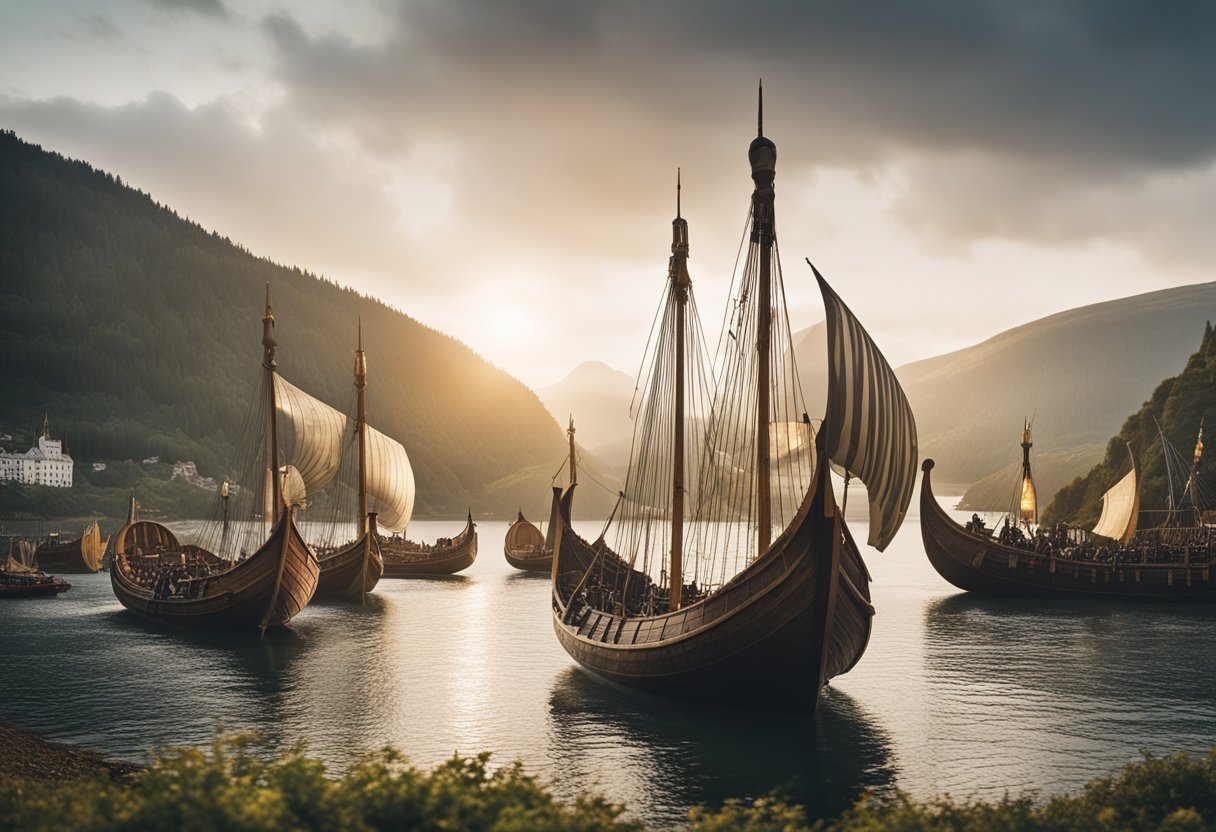
The Viking Age marked a period of significant economic transformation in Scandinavia, underpinned by extensive trading networks and agricultural expansion. These economic activities not only supported Viking societies but also contributed to their influence across Europe.
Trading Hubs and Goods
During the Viking Age, strategic trading hubs were established, where tin, wood, iron, and fur were among the commodities exchanged, contributing to the Norsemen’s riches. Notably, Ribe emerged as a prominent centre for trade in Denmark around the 8th century. The town served as a melting pot of various cultures and a marketplace for goods from near and far, including local Scandinavian products and imported items. This network of trading hubs connected the Vikings with the rest of Europe and beyond, allowing for the exchange of not only goods but also culture and ideas.
Key Trading Goods
- Tin: Used for pewter and bronze making.
- Wood: Essential for shipbuilding and homes.
- Iron: Forged into weapons and tools.
- Fur: Sought after for warmth and status.
Agriculture and Resource Usage
Farming was the bedrock of the Viking economy within their own lands, utilising Scandinavia’s fertile areas to grow crops and rear livestock. The Vikings also harnessed natural resources effectively, with fishing playing a vital role in their sustenance and trade. The management of these resources was sophisticated, ensuring that farming and fishing could sustain the community while also providing a surplus for trade.
Primary Resources
- Crops: Barley, rye, and oats.
- Livestock: Cattle, sheep, and pigs.
- Fish: A staple in the Viking diet and trade.
Mythology and Spirituality
Within the tapestries of Norse legends, mythology and spirituality are intricately woven together, forming a worldview rich with gods, myths, and rituals. These elements helped shape the morals and culture of the Viking Age.
The Pantheon of Norse Gods
The Norse gods are central to Scandinavian mythology, embodying a range of powerful forces and traits. Thor, the god of thunder, is renowned for his strength and the protection he offers against chaos. Odin, the Allfather, is the god of wisdom, poetry, and war, often seeking knowledge at great cost. These deities resided in Valhalla and other realms, influencing the natural and supernatural worlds. Within the legends, each god had specific domains and stories, where their interactions with humans, giants, and other beings were chronicled in rich poetry and narratives.
Rituals and Beliefs
The Vikings practised rituals to honour their gods and secure their favour. Small and significant sacrifices were a core aspect, aiming to ensure prosperity, success in battle, or a good harvest. Beliefs were not merely for the afterlife but interwoven in daily life; they governed social conduct and law. Access to the afterlife, such as entry to Valhalla, the hall of slain warriors, depended on one’s deeds and the gods’ judgments. The myths served not only as spiritual guidance but also as cultural cornerstones that solidified communal values and traditions.
Arts and Artistry of the Vikings
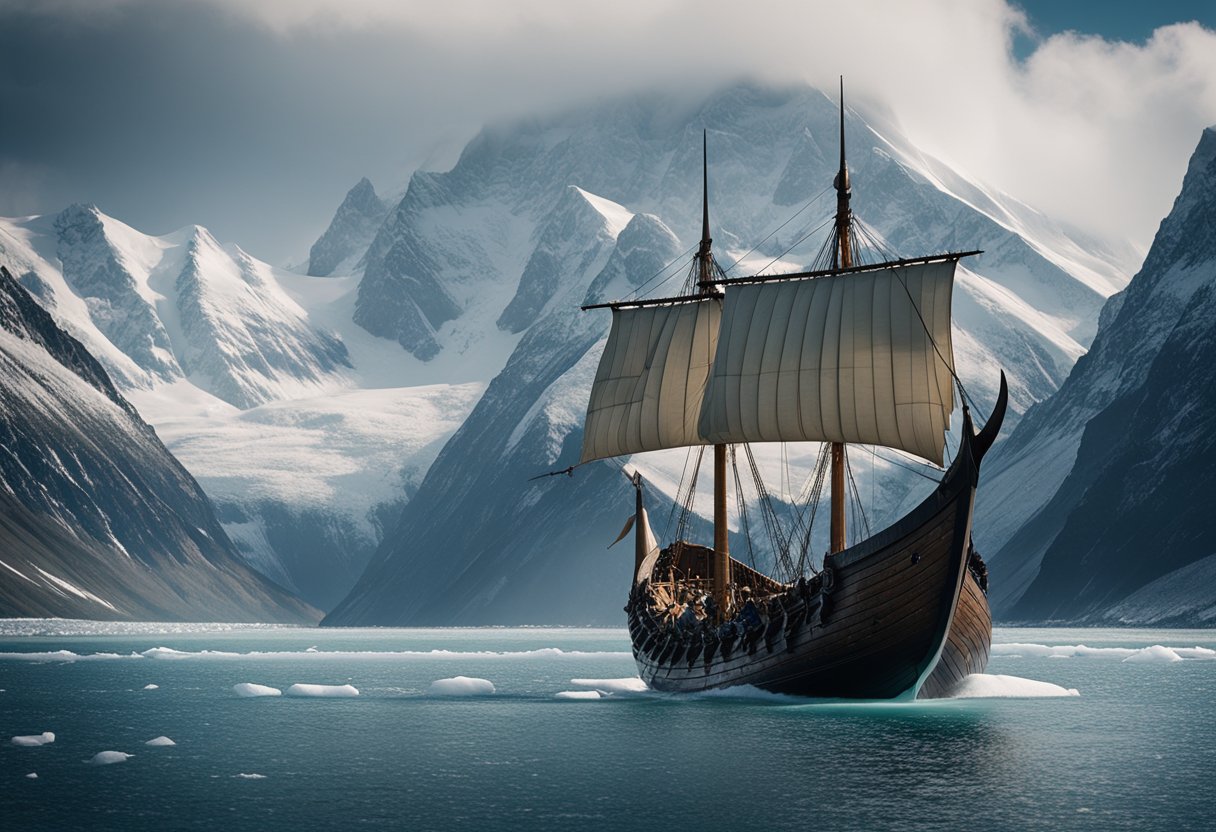
In our exploration of Viking history, the richness of Norse artistry is evident through their varied crafts and legendary sagas. Their artistic endeavours were not only decorative but also a reflection of their societal values and stories.
Craftsmanship and Design
The Vikings were skilled artisans, and their craftsmanship was a testament to their culture and identity. Their intricate works ranged from wood carvings to elaborate jewellery. Common design motifs included interlaced patterns, geometric shapes, and an array of animal forms. Carvings on their revered longships and everyday objects were not just ornamental but showcased their exceptional woodworking skills.
Artefacts such as the Oseberg longship feature the “ribbon-animal” and the “gripping beast” motifs, which speak of mythic tales and the importance of animals in their cosmology. These designs are found across various Viking artefacts, thus revealing a visual language that resonated throughout their culture. A visit to the Art of the Viking Age at Smarthistory offers a deeper understanding of the diversity of Viking artistic expressions.
Viking Storytelling
Nested within the Norse sagas is a wealth of Viking storytelling, narrating the lives of their ancestors and gods. As these tales were passed down orally, the use of poetry and dramatic recounts was indispensable. Storytelling was more than entertainment; it was a way to preserve history and impart crucial cultural lessons.
The sagas, encompassing both historical narratives and mythological tales, underline the importance of honour, bravery, and the supernatural in Viking society. They offer invaluable insights into the Viking worldview and are an integral part of our understanding of Norse history. For a deeper delve into their story in sagas complemented by archaeological evidence, one could explore insights from TheCollector.
Societal Structures and Law
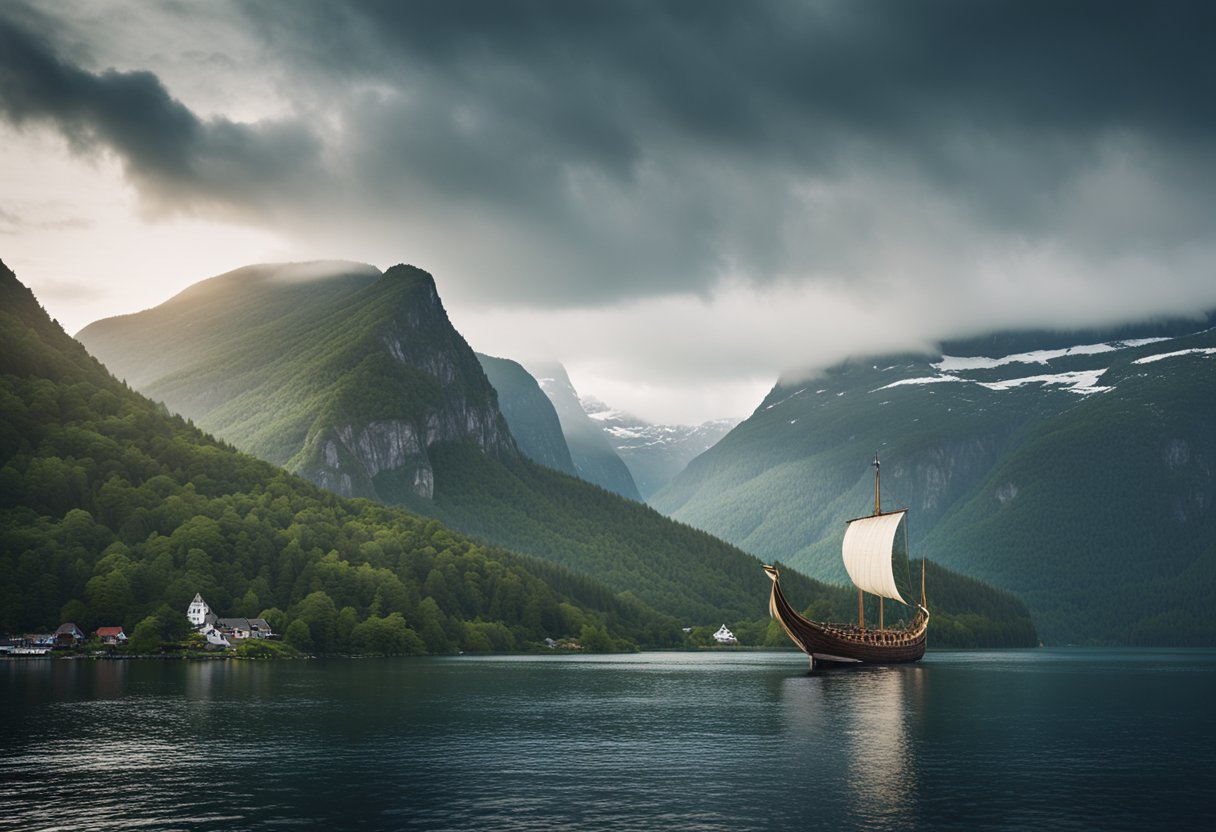
As we explore the Viking Age, it’s essential to understand the complexity of their societal systems and the laws that governed their communities. These elements were not only crucial for internal order but also for shaping Norse culture.
Roles and Classes
Within the Norse society, there were clearly defined roles and classes. At the apex were the earls (Old Norse jailer), who wielded political power and owned large estates. Free men and women who could own property and engage in trade were the backbone of daily life. However, slaves—known in Old Norse as thralls—were at the bottom of this hierarchy, often captured during raids. This trifecta formed the core classes that structured every aspect from work to warfare and even factored into Norse legends and sagas, where characteristics of these classes were portrayed.
The Viking’s societal roles played a pivotal part in their expansions as settlers, establishing new colonies where these social classes often migrated to and reflected their homeland’s structures. The importance of class identity is a recurring theme in the Sagas, intricately woven into their culture as much as their law and war efforts.
Legal Systems
The Norse legal system, sophisticated for its time, revolved around the thing—a gathering akin to an assembly where laws were recited and disputes settled. Each thing was presided over by a law speaker, who would memorise and recite the law, while matters were judged with input from the community, particularly the free men. This process underscored their legislative and judiciary frameworks that influenced the Viking’s culture and their interaction with lands they explored or conquered.
While settlers abroad brought their legal customs with them, local things adapted to fit their new environments, underpinning the notion that Viking law was both transportable and adaptable. As much as their fierce reputation in war, their legal systems were a cornerstone of their society’s sustainability and influenced the legal frameworks in regions such as the Danelaw in England.
Influences on Foreign Lands
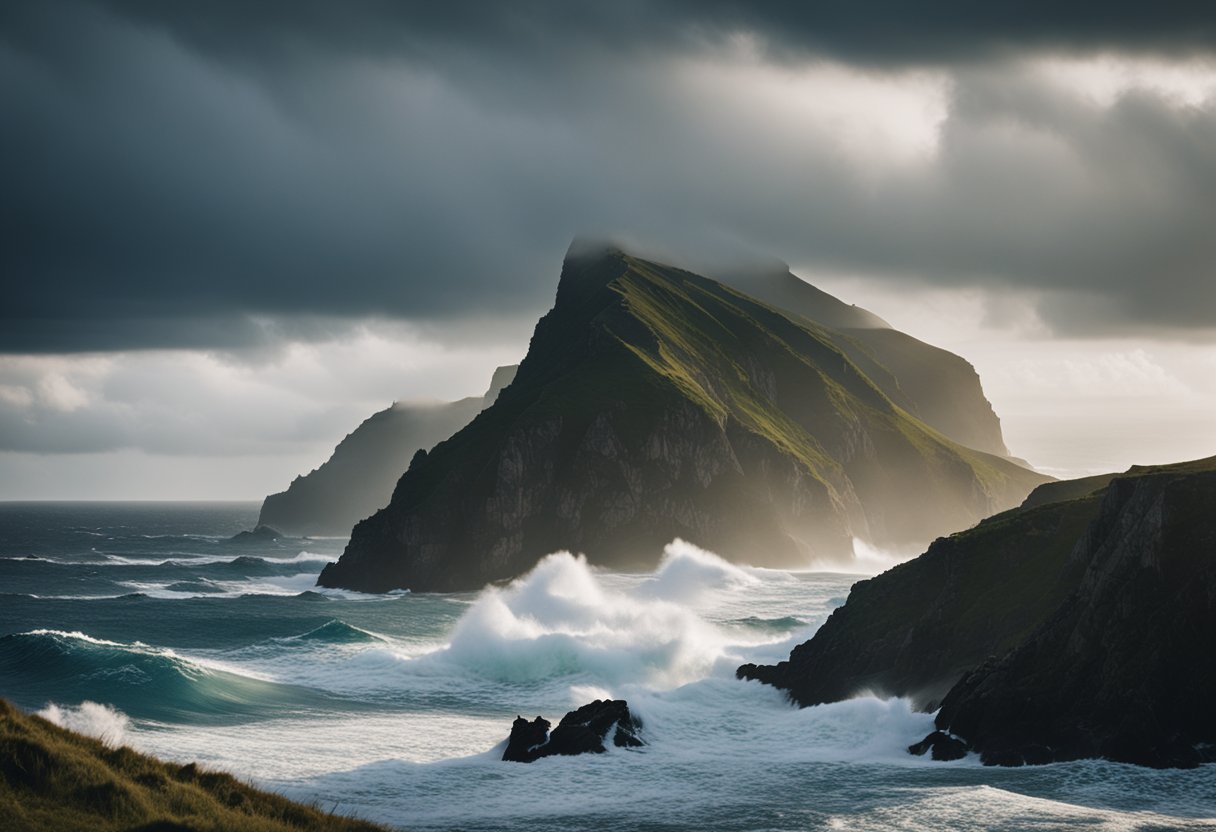
The Viking incursions and subsequent settlements left a lasting imprint on many regions, including the shaping of political boundaries and the introduction of Norse culture into local societies.
Scandinavian Impact on England and Ireland
In England, the arrival of the Vikings led to the establishment of the Danelaw—a legal and cultural region in which Danish law was observed, covering large areas of the north and east. This had profound effects on local governance and the evolution of the English language, with Scandinavian words becoming integrated into English vocabulary. Towns like York and Wessex were significantly influenced by these Norse settlers.
Across the Irish Sea, Norsemen founded coastal strongholds that later evolved into major cities. For example, Dublin, Waterford, and Limerick trace their origins back to Viking settlers. The integration of Norse practices in these areas fostered a cultural exchange, blending Scandinavian traditions with the local Gaelic.
Viking Legacy in Eastern Europe
The Viking influence extended far into Eastern Europe; Novgorod and Kiev owe their establishment to these intrepid Scandinavian traders and warriors. Known to the East Slavs as ‘Varangians’, the Vikings contributed to developing trade networks across the region, utilising major waterways to transport commodities, including lucrative Scandinavian furs. Their legacy in Eastern Europe is encapsulated in the formation of territorial units that later became part of the foundation for modern states.
Technological Innovations and Viking Seafaring
The Vikings were formidable seafarers, owing much of their maritime prowess to technological strides in shipbuilding and navigation. Their advancements facilitated unprecedented voyages across the North Atlantic, leading to the exploration and settlement of lands, including Greenland and Iceland, and even reaching North America.
Shipbuilding and Navigation
The ability to construct advanced ships was the linchpin of Viking success on the seas. These Nordic craftsmen created the iconic longship, which was agile, swift, and sturdy enough to withstand the brutal North Atlantic swells. Key design elements included overlapping planks (clinker-built hull), shallow draught for nearshore navigation, and symmetrical bow and stern, allowing rapid change of direction. This vessel was integral to Viking raids, enabling them to strike coastal towns across Europe swiftly.
Advancements in navigation technology also played a crucial role. On clear days, the Vikings could steer their courses using the sun’s position. For overcast conditions, they turned to the Iceland spar, a clear mineral believed to help Vikings locate the sun’s position through polarization.
Sailing Technology
Viking sailing technology was, without a doubt, ahead of its time, with their sails being pivotal for their lengthy voyages. They utilised a single, large, square sail made of woollen cloth, typically dyed vibrant reds or blues to stand out. This sail harnessed the wind’s power, propelling longships over distances that stretched from Scandinavia to the shores of North America.
The Vikings’ understanding of the wind and ocean currents underpinned their sailing tactics. Their intimate knowledge of these natural forces enabled them to embark on transatlantic journeys to Greenland and beyond, cementing their reputation as skilled navigators and bold explorers.
End of the Viking Era and Historical Legacy
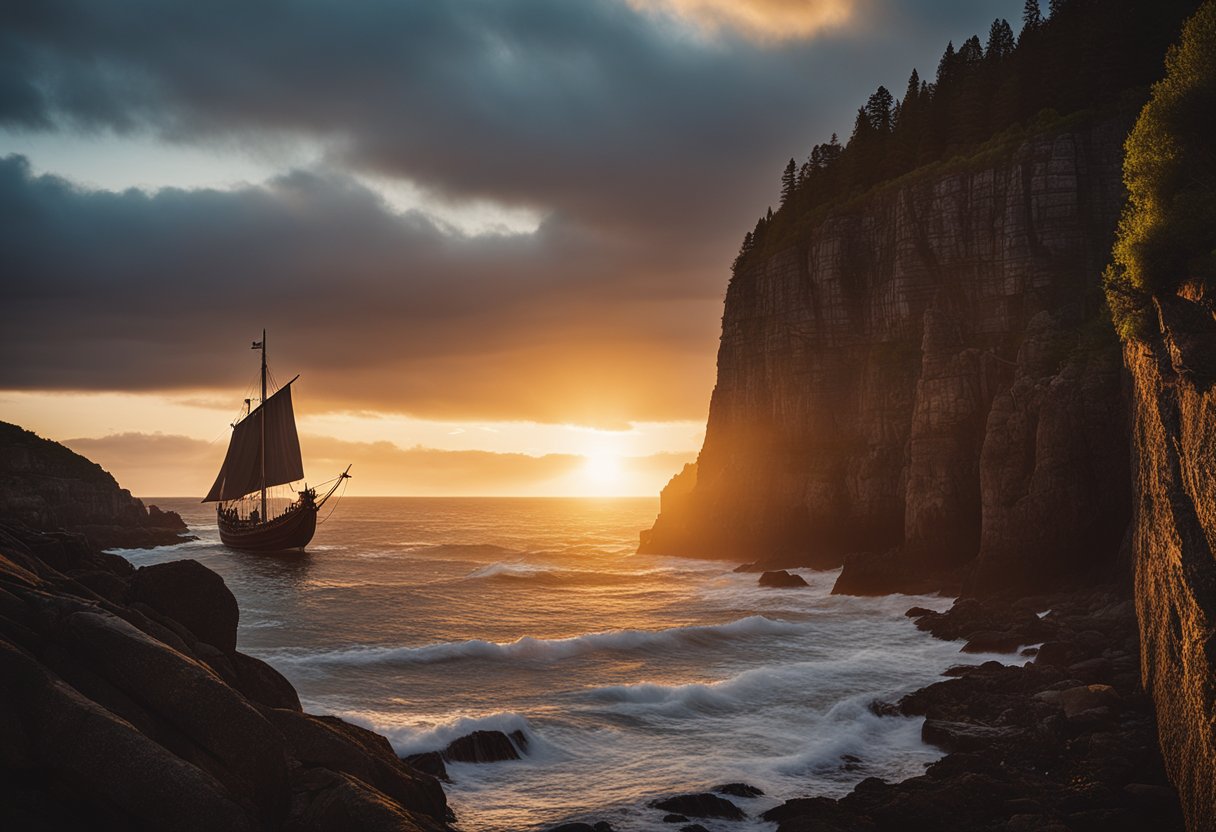
The Viking Era came to a close, marked by significant confrontations, and its impact on culture remains evident even today.
Battles and the Fall of Viking Kingdoms
The conclusion of the Viking Age was precipitated by pivotal conflicts and changes in power structures across Europe. The Battle of Stamford Bridge in 1066 is a landmark event, signifying the end of Viking dominance when King Harold II of England emerged victorious against the Norwegian forces of Harald Hardrada. This defeat, alongside the rise of powerful monarchs like Harald Bluetooth, Sven Forkbeard, and Knut in Scandinavia, who embraced Christianity, signalled a shift from raiding to consolidated governance. England, too, witnessed transformation as the Norman conquest by William, Duke of Normandy, commenced a new epoch.
Vikings in Modern Culture
Vikings have left an indelible mark on modern culture, capturing the imagination through tales of their conquests and exploratory exploits. From the sagas and runes that document their mythology and traditions to the enduring legacy of Viking settlements in Normandy, their influence permeates various facets of modern European identity. Viking symbology and narratives continue to inspire literature, television, and film, illustrating the lasting fascination with their history and the landscapes they shaped. Figures like Edward the Confessor and events such as the establishment of Danelaw have been essential in shaping England’s early medieval history, blending Norse culture with the evolving Christian kingdoms.
Frequently Asked Questions
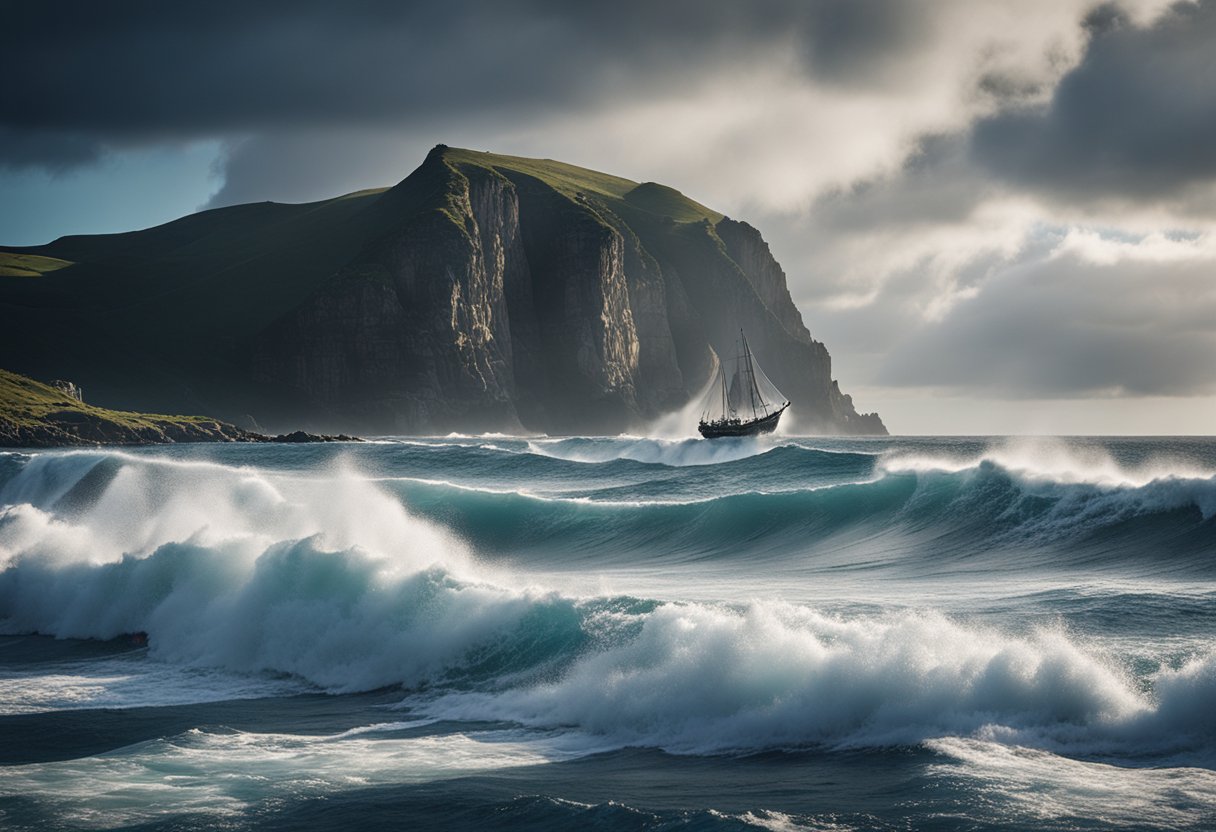
In this section, we’ve compiled some of the most common queries about the rich tapestry of Viking sagas and the historical and cultural landscapes they traverse.
What themes are prevalent in Norse mythology and saga narratives?
In the Norse sagas, themes of honour, bravery, fate vs. free will, and the inevitability of death are widely explored. These narratives often portray the Viking ethos of perseverance in the face of adversity.
Which regions did the Vikings discover during their explorations?
During their explorations, Vikings reached remote regions, including the North Atlantic Isles, parts of the British Isles, Russia, Greenland, and even Iceland, where they settled despite the harsh landscapes.
What is the most renowned Viking saga and its significance?
The most famous Viking saga is arguably the Heimskringla, a collection of kings’ sagas that not only chronicles Norse monarchs’ lives but also provides a view into the political landscape of the era.
How do Viking sagas reflect the culture and beliefs of Scandinavian society?
Viking sagas mirror the culture and beliefs rooted in Scandinavian society by emphasising the importance of family lineage, social status, and interaction with gods and mythical beings, which embody their spiritual convictions and societal norms.
Can you recommend any literature that delves into Viking explorations and Norse myths?
We can suggest reading the Saga of the Völsungs for an epic narrative that intertwines the Völsung clan’s legend with the tales of gods and monsters central to Norse mythology.
What historical impact did Viking expeditions have on European landscapes?
The historical impact of Viking expeditions on European landscapes was profound. They established new trade routes and towns and blended cultures, while their military prowess and shipbuilding innovations had lasting influences on maritime technology and warfare strategies.






